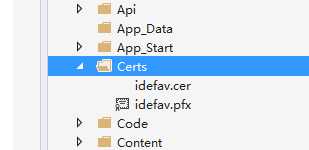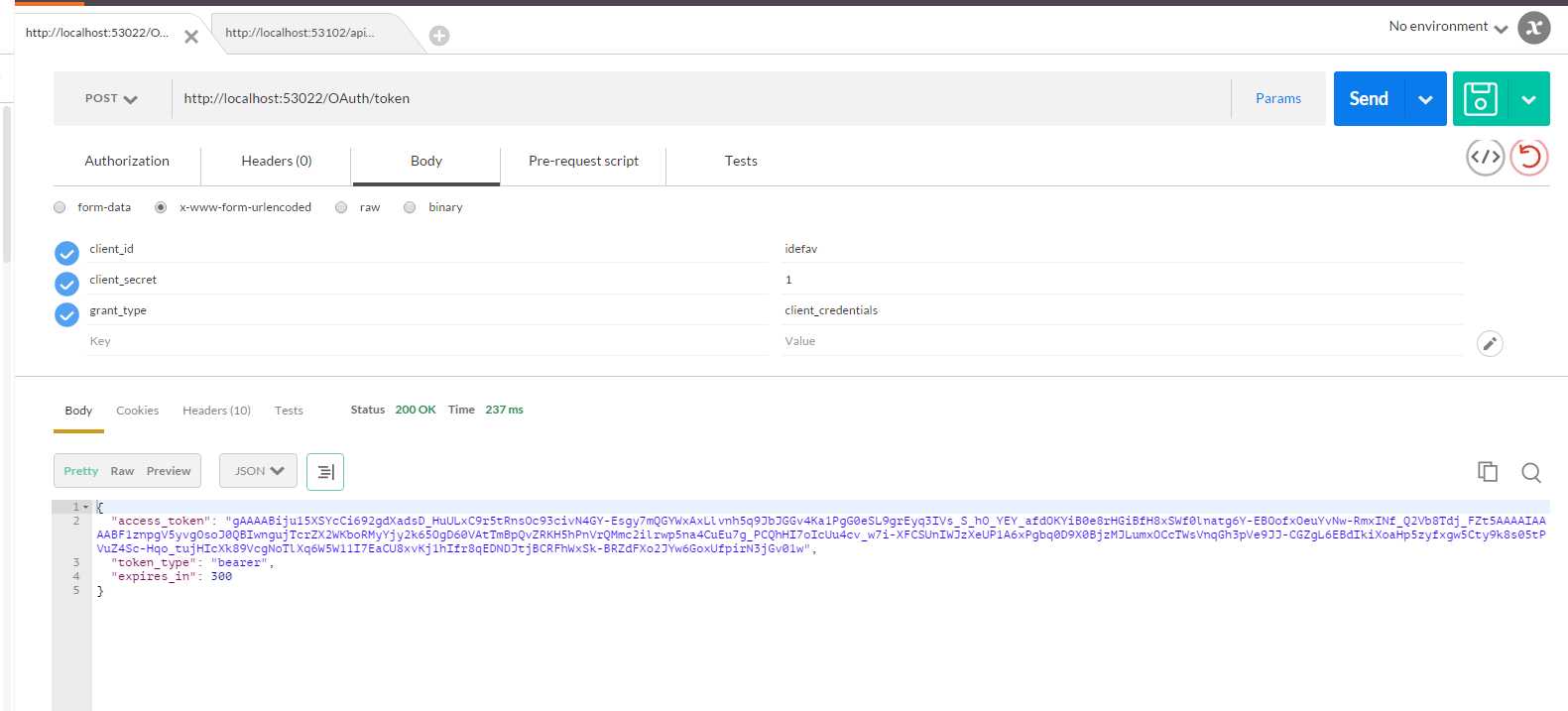标签:
系列目录:
DotNetOpenAuth实践系列(源码在这里)
上篇我们讲到WebApi资源服务器配置,这篇我们说一下Webform下的ashx,aspx做的接口如何使用OAuth2认证
一、环境搭建
1、新建Webform项目

2、使用Nuget添加DotNetOpenAuth 5.0.0 alpha3
3、把上次制作的证书文件拷贝的项目中

二、编写关键代码
1、公共代码
ResourceServerConfiguration
1 using System.Security.Cryptography.X509Certificates; 2 3 namespace WebformResourcesServer.Code 4 { 5 public class ResourceServerConfiguration 6 { 7 public X509Certificate2 EncryptionCertificate { get; set; } 8 public X509Certificate2 SigningCertificate { get; set; } 9 } 10 }
Common.cs
1 namespace WebformResourcesServer.Code 2 { 3 public class Common 4 { 5 public static ResourceServerConfiguration Configuration = new ResourceServerConfiguration(); 6 } 7 }
Global
1 using System; 2 using System.Collections.Generic; 3 using System.Linq; 4 using System.Security.Cryptography.X509Certificates; 5 using System.Web; 6 using System.Web.Optimization; 7 using System.Web.Routing; 8 using System.Web.Security; 9 using System.Web.SessionState; 10 using WebformResourcesServer.Code; 11 12 namespace WebformResourcesServer 13 { 14 public class Global : HttpApplication 15 { 16 void Application_Start(object sender, EventArgs e) 17 { 18 Common.Configuration = new ResourceServerConfiguration 19 { 20 EncryptionCertificate = new X509Certificate2(Server.MapPath("~/Certs/idefav.pfx"), "a"), 21 SigningCertificate = new X509Certificate2(Server.MapPath("~/Certs/idefav.cer")) 22 }; 23 // 在应用程序启动时运行的代码 24 RouteConfig.RegisterRoutes(RouteTable.Routes); 25 BundleConfig.RegisterBundles(BundleTable.Bundles); 26 } 27 } 28 }
2、关键代码
ashxhandler
1 using System; 2 using System.Collections.Generic; 3 using System.Linq; 4 using System.Net.Http; 5 using System.Security.Cryptography; 6 using System.Security.Principal; 7 using System.Threading; 8 using System.Threading.Tasks; 9 using System.Web; 10 using System.Web.UI; 11 using DotNetOpenAuth.Messaging; 12 using DotNetOpenAuth.OAuth2; 13 14 namespace WebformResourcesServer.Code 15 { 16 public class AshxHandler 17 { 18 public AshxHandler(HttpContext context) 19 { 20 Context = context; 21 } 22 23 public HttpContext Context { get; set; } 24 25 private async Task<IPrincipal> VerifyOAuth2(HttpRequestBase httpDetails, params string[] requiredScopes) 26 { 27 var resourceServer = new ResourceServer(new StandardAccessTokenAnalyzer((RSACryptoServiceProvider)Common.Configuration.SigningCertificate.PublicKey.Key, (RSACryptoServiceProvider)Common.Configuration.EncryptionCertificate.PrivateKey)); 28 return await resourceServer.GetPrincipalAsync(httpDetails, requiredScopes: requiredScopes); 29 30 } 31 32 public async Task Proc(Action<HttpContext> action) 33 { 34 try 35 { 36 var principal = await VerifyOAuth2(new HttpRequestWrapper(Context.Request)); 37 if (principal != null) 38 { 39 Context.User = principal; 40 Thread.CurrentPrincipal = principal; 41 action.Invoke(Context); 42 } 43 } 44 catch (ProtocolFaultResponseException exception) 45 { 46 var outgoingResponse = await exception.CreateErrorResponseAsync(CancellationToken.None); 47 Context.Response.StatusCode = (int)outgoingResponse.StatusCode; 48 //Context.Response.SuppressContent = true; 49 foreach (var header in outgoingResponse.Headers) 50 { 51 52 //Context.Response.Headers[header.Key] = header.Value.First(); 53 Context.Response.AddHeader(header.Key, header.Value.First()); 54 } 55 Context.Response.Write(exception.Message); 56 } 57 } 58 } 59 }
3、添加一个ashx文件
目录:

代码:
1 using System; 2 using System.Threading; 3 using System.Threading.Tasks; 4 using System.Web; 5 using WebformResourcesServer.Code; 6 7 namespace WebformResourcesServer.Api 8 { 9 /// <summary> 10 /// Values 的摘要说明 11 /// </summary> 12 public class Values : IHttpAsyncHandler 13 { 14 15 public void ProcessRequest(HttpContext context) 16 { 17 context.Response.ContentType = "text/plain"; 18 } 19 20 public bool IsReusable 21 { 22 get 23 { 24 return false; 25 } 26 } 27 28 public IAsyncResult BeginProcessRequest(HttpContext context, AsyncCallback cb, object extraData) 29 { 30 return new AsyncResult(cb, extraData, new AshxHandler(context).Proc(c => 31 { 32 c.Response.Write("The Data you get!"); 33 })); 34 35 36 } 37 38 public void EndProcessRequest(IAsyncResult result) 39 { 40 var r = (AsyncResult)result; 41 r.Task.Wait(); 42 43 } 44 } 45 46 internal class AsyncResult : IAsyncResult 47 { 48 private object _state; 49 private Task _task; 50 private bool _completedSynchronously; 51 52 public AsyncResult(AsyncCallback callback, object state, Task task) 53 { 54 _state = state; 55 _task = task; 56 _completedSynchronously = _task.IsCompleted; 57 _task.ContinueWith(t => callback(this), TaskContinuationOptions.ExecuteSynchronously); 58 } 59 60 public Task Task 61 { 62 get { return _task; } 63 } 64 65 66 public object AsyncState 67 { 68 get { return _state; } 69 } 70 71 public WaitHandle AsyncWaitHandle 72 { 73 get { return ((IAsyncResult)_task).AsyncWaitHandle; } 74 } 75 76 public bool CompletedSynchronously 77 { 78 get { return _completedSynchronously; } 79 } 80 81 public bool IsCompleted 82 { 83 get { return _task.IsCompleted; } 84 } 85 } 86 }
4、测试
获取access_token

访问api

如果token不正确

到这篇为止,本系列基本结束,如果有不明白的地方可以评论留言,感谢大家的关注
DotNetOpenAuth实践之Webform资源服务器配置
标签:
原文地址:http://www.cnblogs.com/idefav2010/p/DotNetOpenAuth_WebformResourcesServer.html